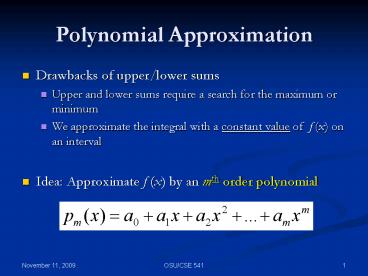Polynomial Approximation - PowerPoint PPT Presentation
1 / 37
Title:
Polynomial Approximation
Description:
The m's (order of the polynomials) may be the same or different ... Composite ... Take the Composite Trapezoid Rule. Assume we have computed an estimate with ... – PowerPoint PPT presentation
Number of Views:51
Avg rating:3.0/5.0
Title: Polynomial Approximation
1
Polynomial Approximation
- Drawbacks of upper/lower sums
- Upper and lower sums require a search for the
maximum or minimum - We approximate the integral with a constant value
of f (x) on an interval - Idea Approximate f (x) by an mth order
polynomial
2
Newton-Cotes Formulas
- Different choices for ms lead to different
formulas - The ms (order of the polynomials) may be the
same or different over each interval - Lets assume it is the same over all intervals
for now
3
Trapezoid Rule
- Simplest way to approximate the area under a
curve using first order polynomial (a straight
line) - Using Newtons form of the interpolating
polynomial - Now, solve for the integral
4
Trapezoid Rule
Trapezoid Rule
5
Trapezoid Rule
- Is this really an improvement?
6
Trapezoid Rule Error
- The integration error is (assume equal spaced
subdivision) - where, h (b a)/n and ? is an unknown point (
a lt ? lt b ) (Intermediate Value Theorem) - What if the function, f, is linear
- Exact integration why?
- f?? 0
7
More intervals, better result error ? O(h2)
8
Composite Trapezoid Rule
- Consider the interval a, b
- Break up the interval into n 1 equally spaced
points. - Let
- Each interval has
9
Composite Trapezoid Rule
- Substitute the trapezoid rule for each integral
- Results in the Composite Trapezoid Formula
10
Composite Trapezoid Rule
- Note Multiple intervals allow us to avoid
duplicate function evaluations and operations - The width times the average height
11
Error Analysis
- The error can be estimated as
- Where, is the average second derivative.
- If n is doubled
- h ? h/2 and Ea ? Ea/4
- The error depends on the width of the area of
integration
12
Example
- Integrate
- a, b 0.2, 0.8
Analytical Answer 12.82
13
Example
- Apply the Trapezoid Rule once
- Error
14
Example
- We dont know ? so approximate with avg. f??
15
Example
- The error can thus be estimated as
16
Trapezoid rule approximation of 11.26 with error
2.37 is within 12 of the true answer
17
Three Intervals
- Use intervals (0.2, 0.4),(0.4, 0.6),(0.6, 0.8)
- (n 3, h 0.2)
Analytical answer is 12.82
18
Et is now within 2
19
Six Intervals
- Use intervals (0.2, 0.3),(0.3, 0,4), etc.
- (n 6, h 0.1)
Analytical answer is 12.82
20
Et is now 0.5
21
Can We Do Better?
- Recap
- Riemann sum
- Trapezoid rule
- What ways can we improve our estimate? Ideas?
- More intervals
- Higher order polynomial
- Use Richardson Extrapolation to examine the limit
as h ? 0
22
Adding More Intervals
- Take the Composite Trapezoid Rule
- Assume we have computed an estimate with interval
size h - Observation Why dont we need to recompute
everything for interval size h/2?
23
Recursive Trapezoid Rule
- We have n? 2n and h?h/2
We computed this already!
24
Romberg Integration
- This is called Romberg Integration
- We combined two O(h2) estimates to get an O(h4)
estimate - Continue by combining two O(h4) estimates to get
an O(h6) estimate - Continue by combining two O(h6) estimates to get
an O(h8) estimate
25
Romberg Integration
- Greater weight is placed on the more accurate
estimate - Weighting coefficients sum to unity
- i.e, (16-1)/151
26
Romberg Integration
- Recursive definition
- j level of subdivision, j1 has more intervals
- k level of integration
- k 1 is original trapezoid estimate O(h2)
- k 2 is improved O(h4), etc.
27
Example
- Consider the function
- Integrate from a 0 to b 0.8
28
Example
- Trapezoid Rules
k 0
k 1
k
j
j 0
j 1
j 2
(j1, k1)
Exact integral is 1.64053334
29
Example
k 1
k 0
k
j
(j2, k1)
Exact integral is 1.64053334
30
Example
k 2
k 1
k
j
(j2, k2)
Exact integral is 1.64053334
31
Example
k
k 1
k 3
k 2
j
Exact integral is 1.64053334
32
Example
- Continue for better results
k 3
(j3, k3)
33
Multi-dimensional Integration
- Apply the Trapezoid Rule to a two-dimensional
function - This leads to weights in the following pattern
34
Multi-dimensional Integration
- Let Aij be the weights to the function evals
35
Multi-dimensional Integration
- The integration in 2D with the Composite
Trapezoid rule
36
Multi-dimensional Integration
- Observations
- Using the weights from the Trapezoid rule still
leaves the error as O(h2) - However, there are now n2 function evaluations
- Equally-spaced samples on a square region
37
Multi-dimensional Integration
- In general, given k dimensions, we have N nk
function evaluations - If the dimension is high, this leads to a
significant amount of additional work in going
from h?h/2. - Note remember this for Monte-Carlo Integration.































